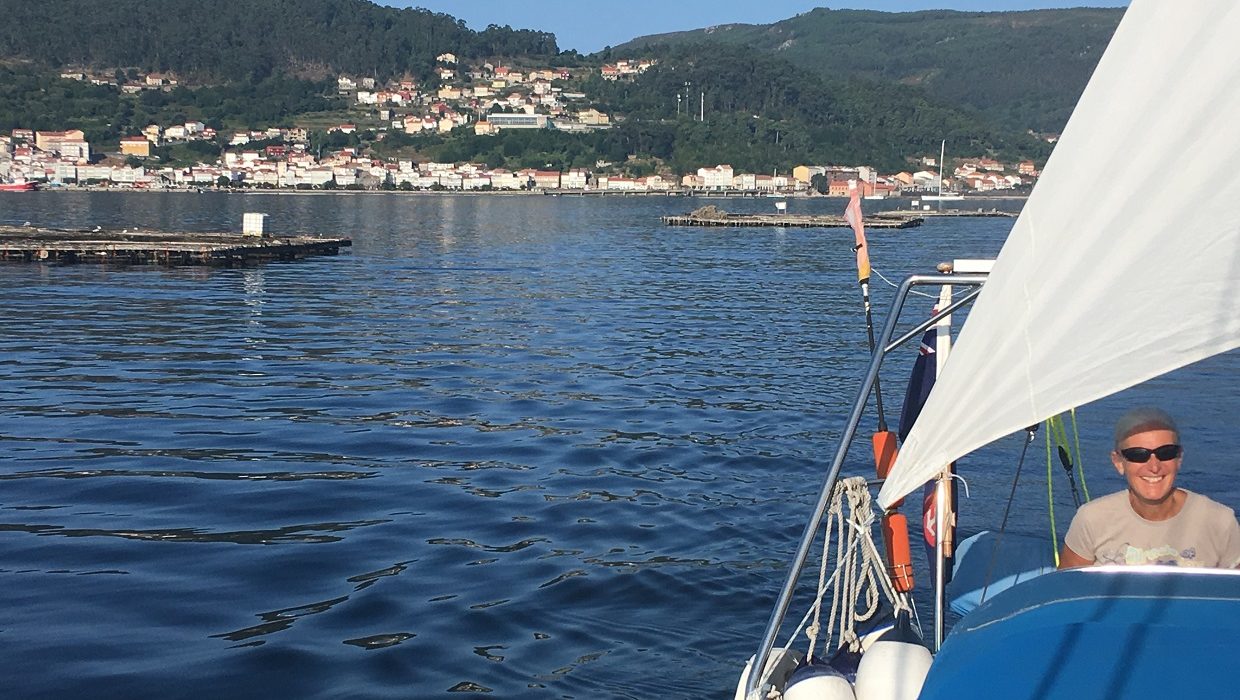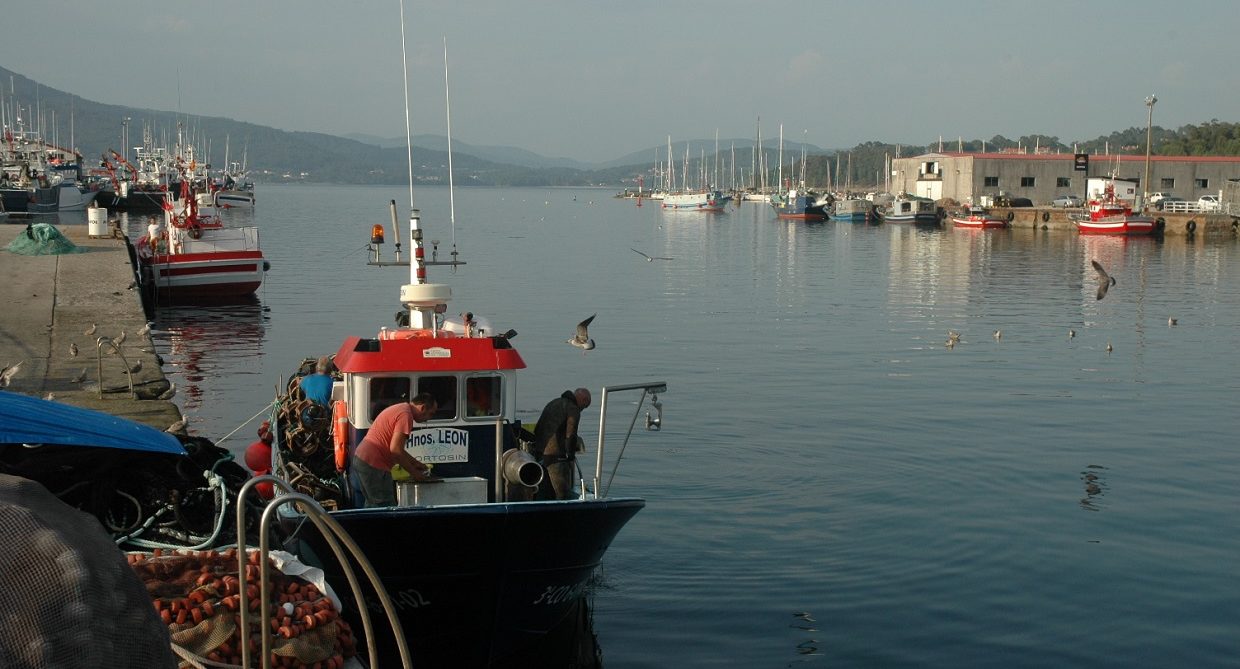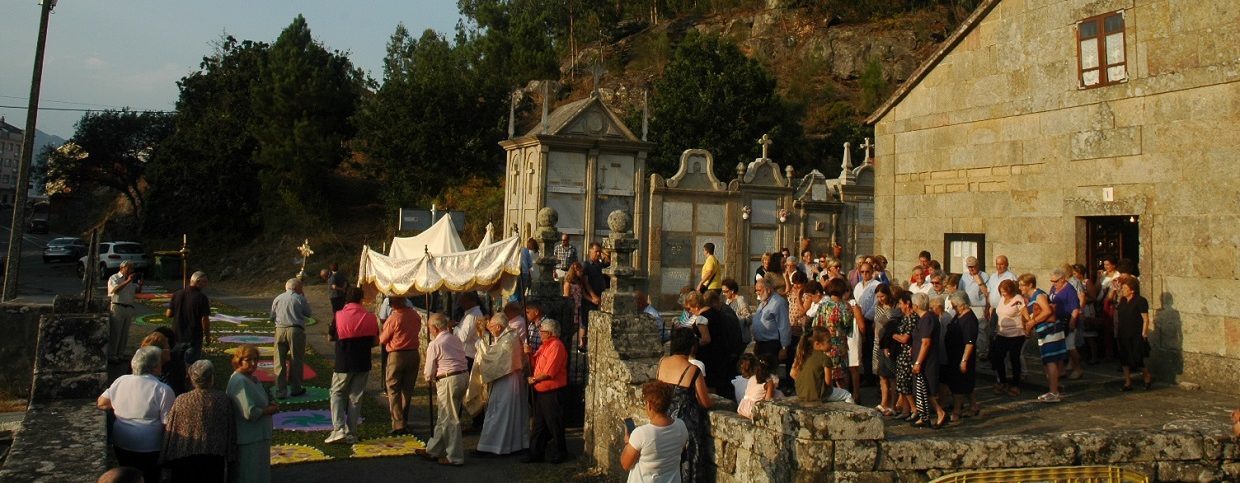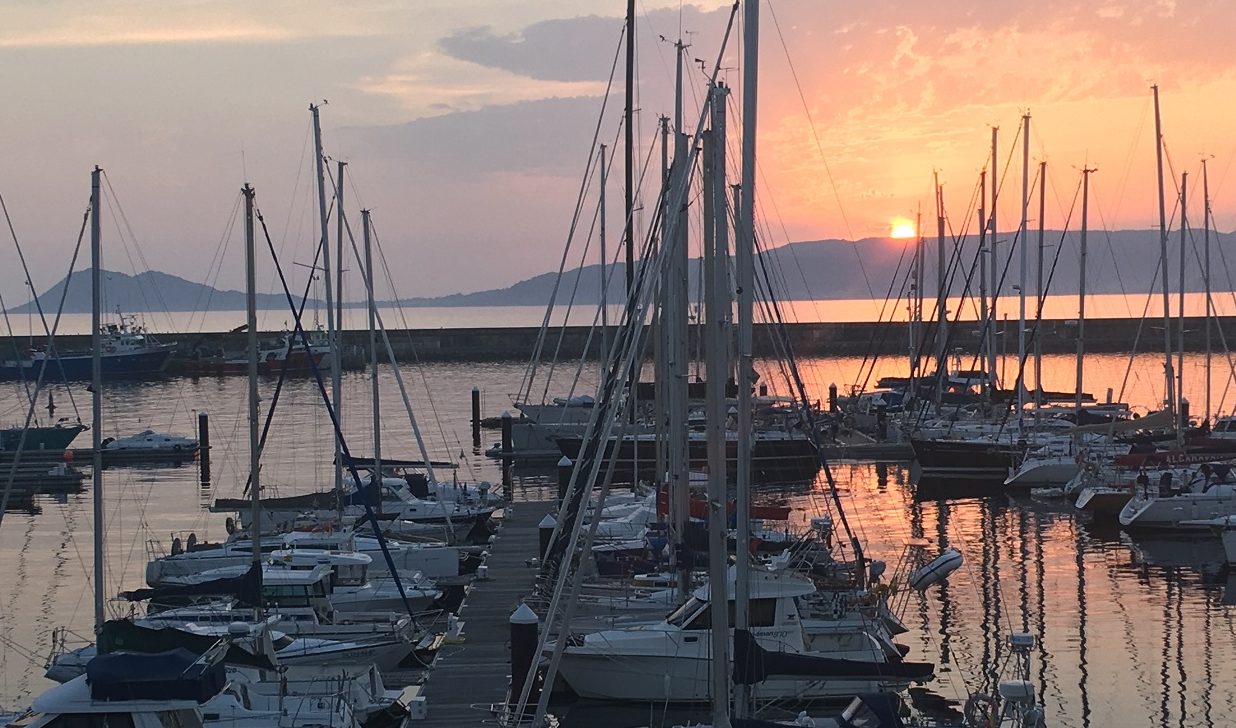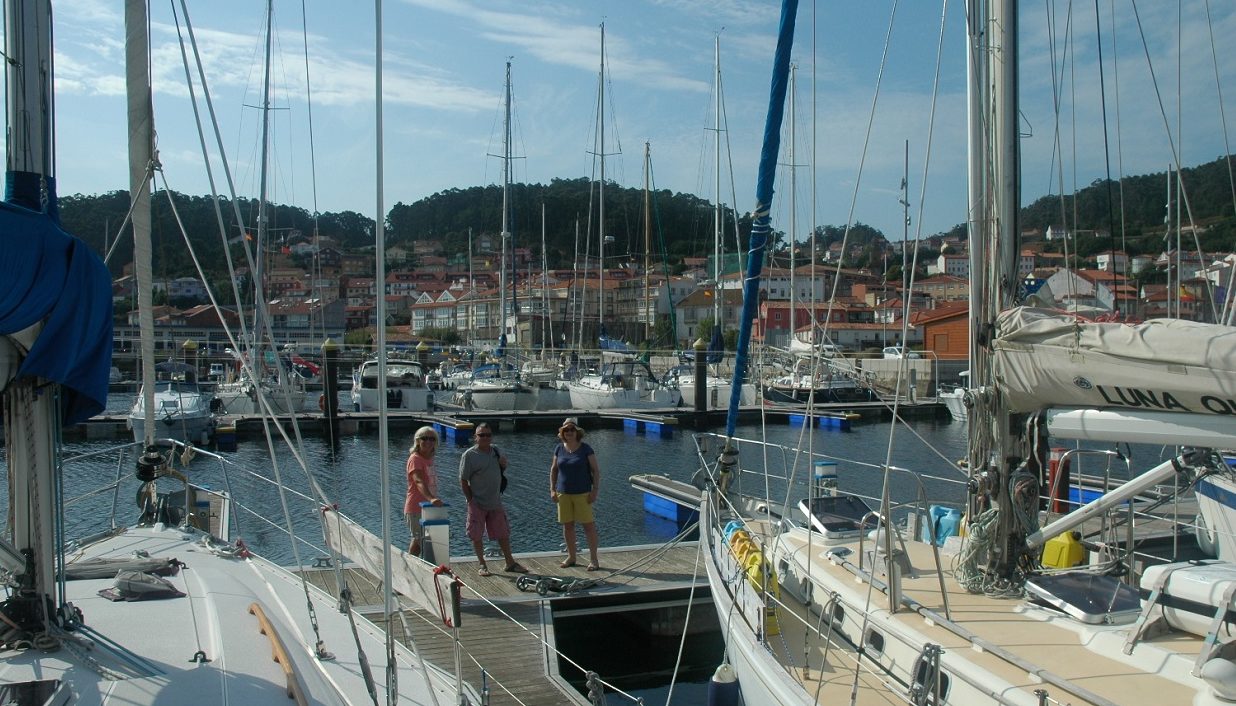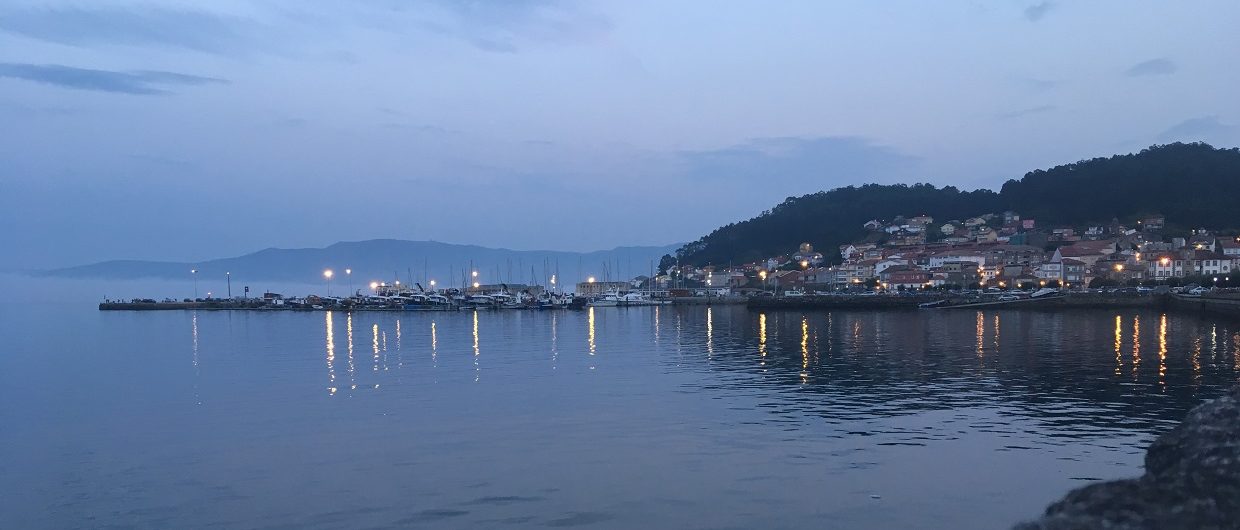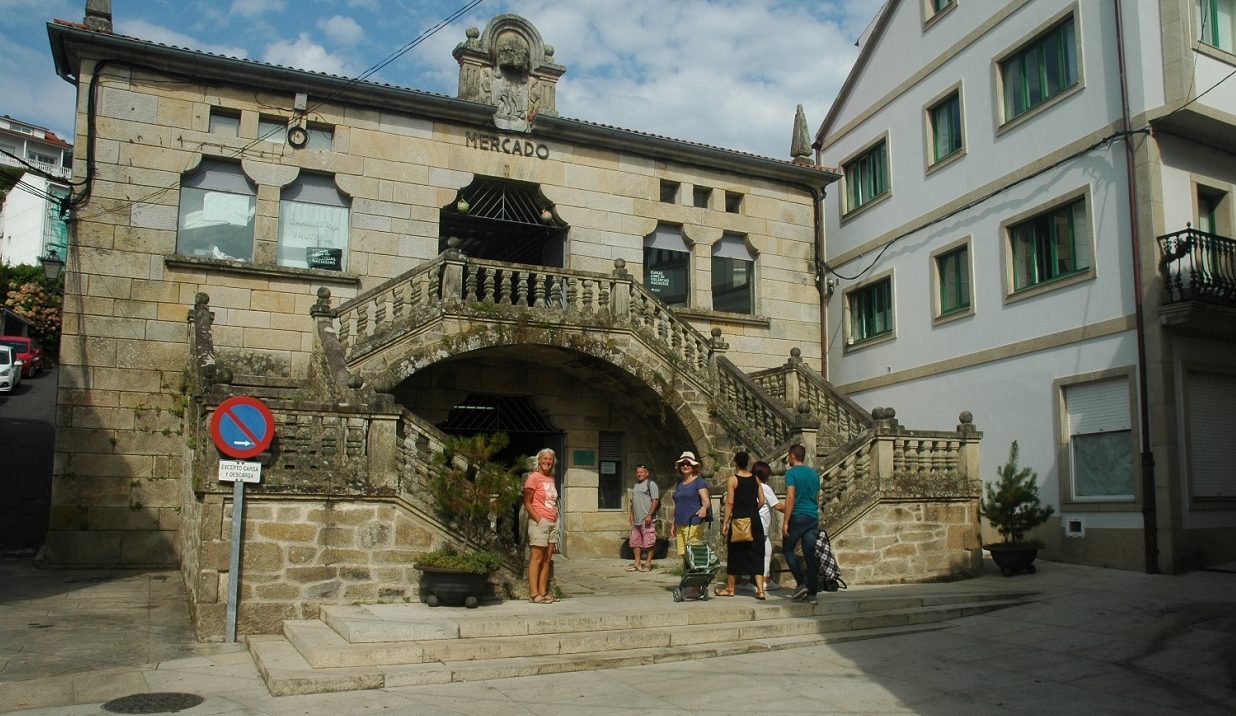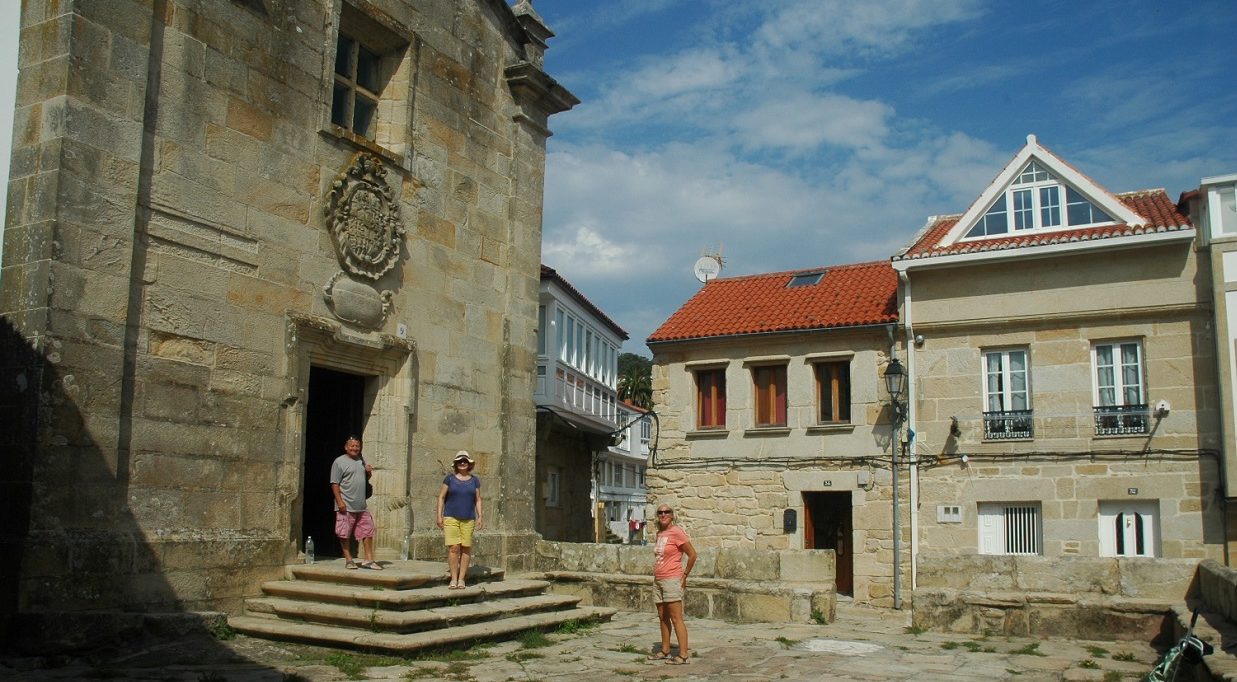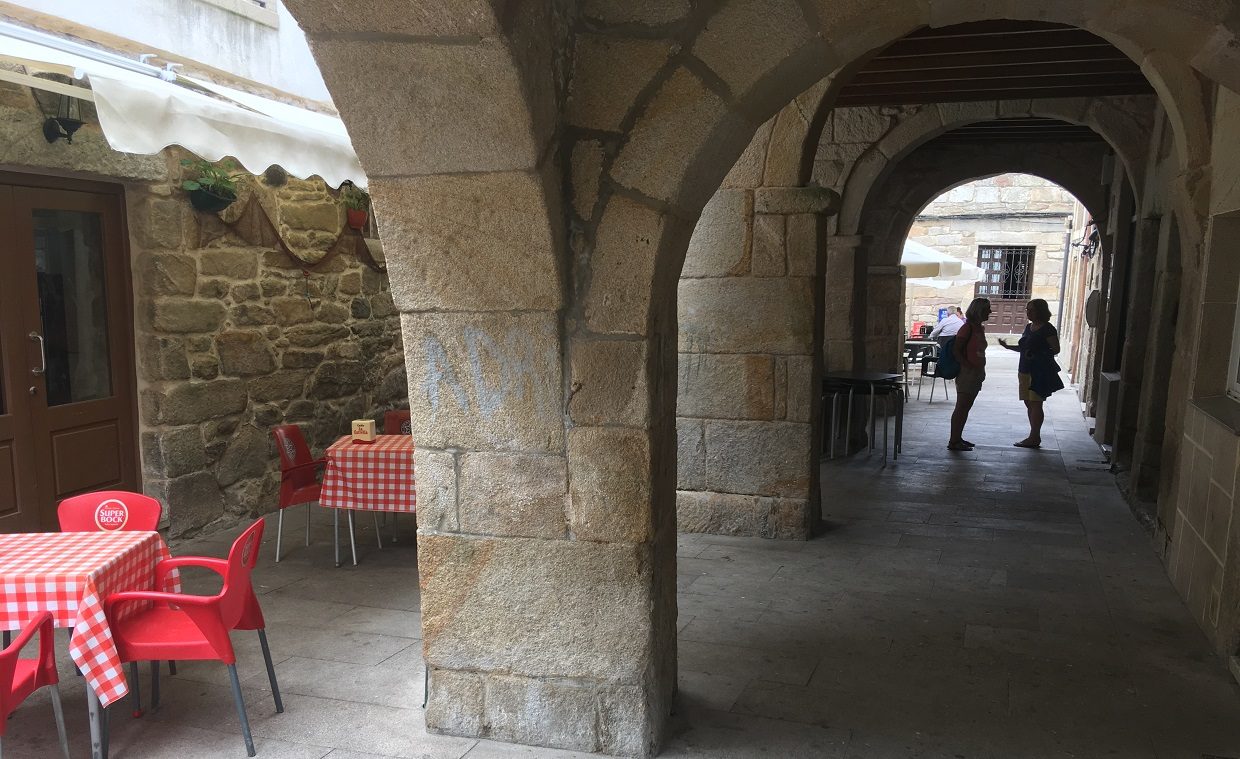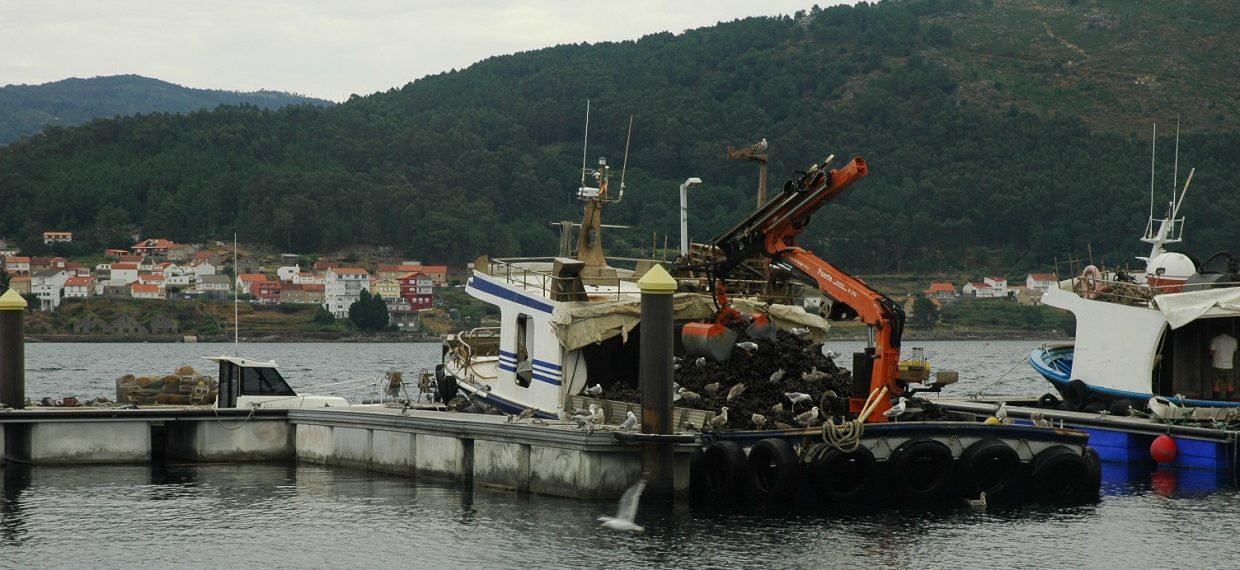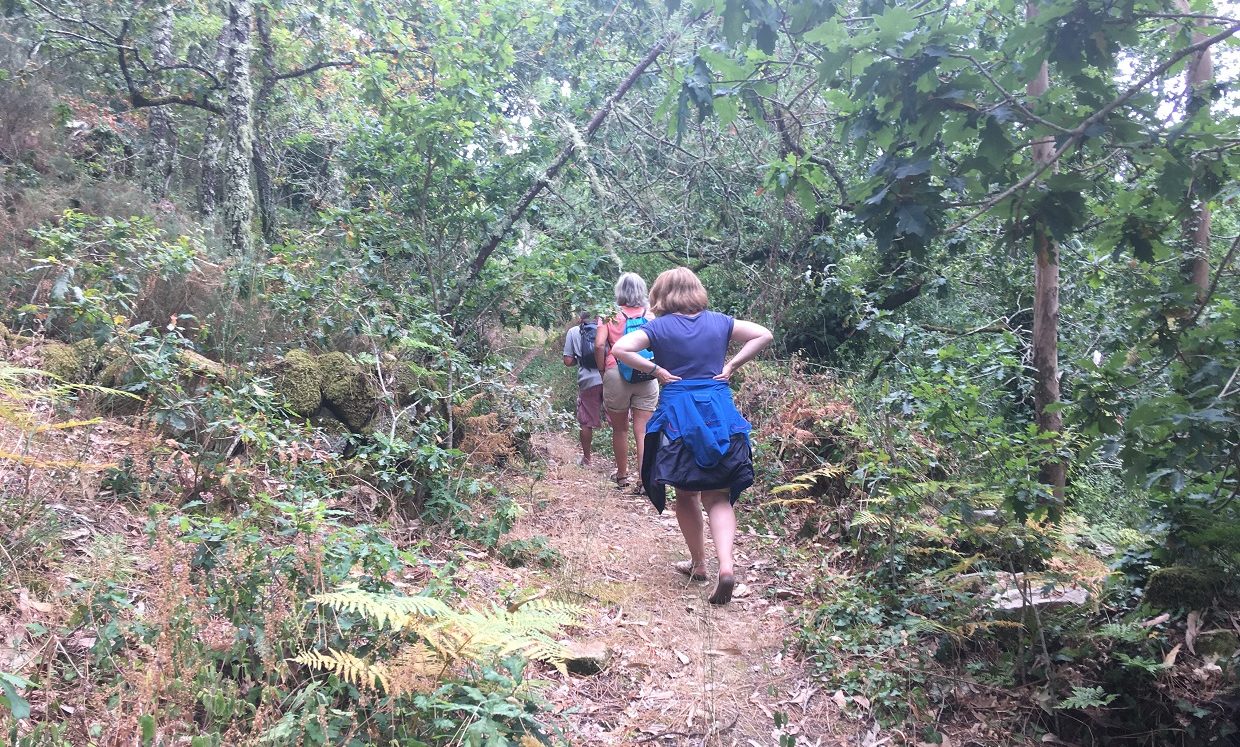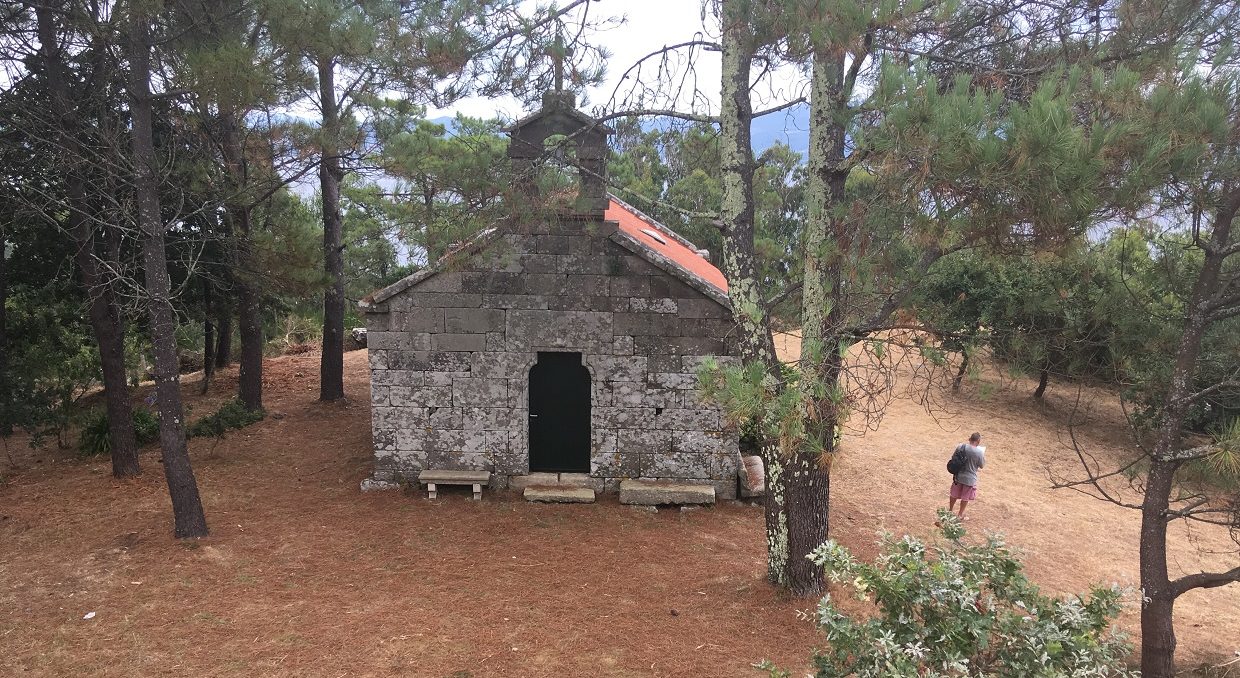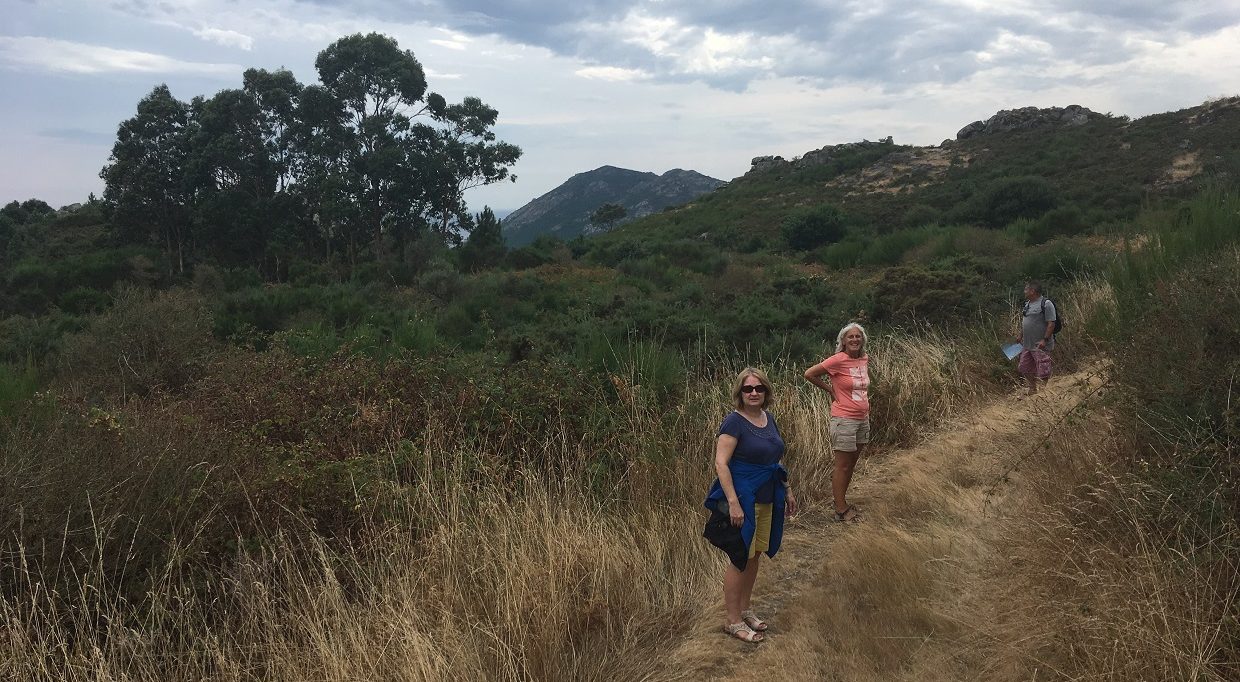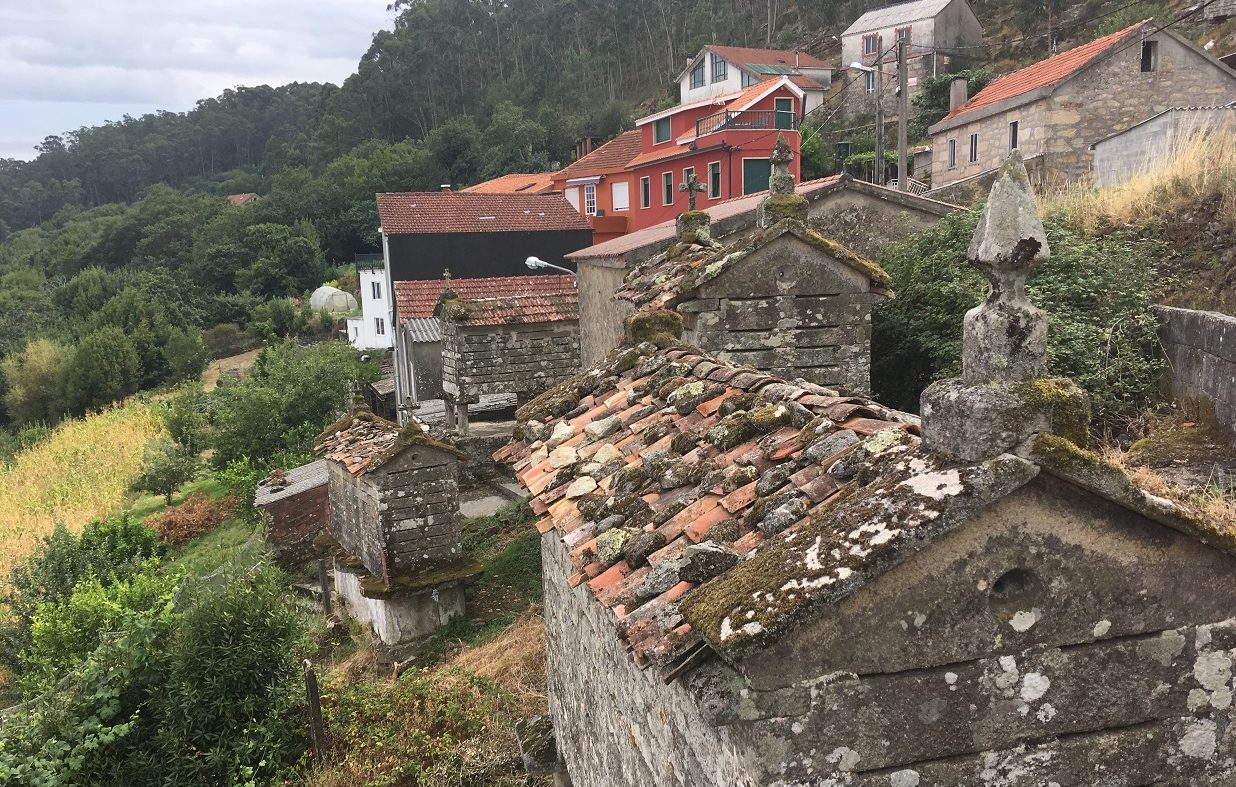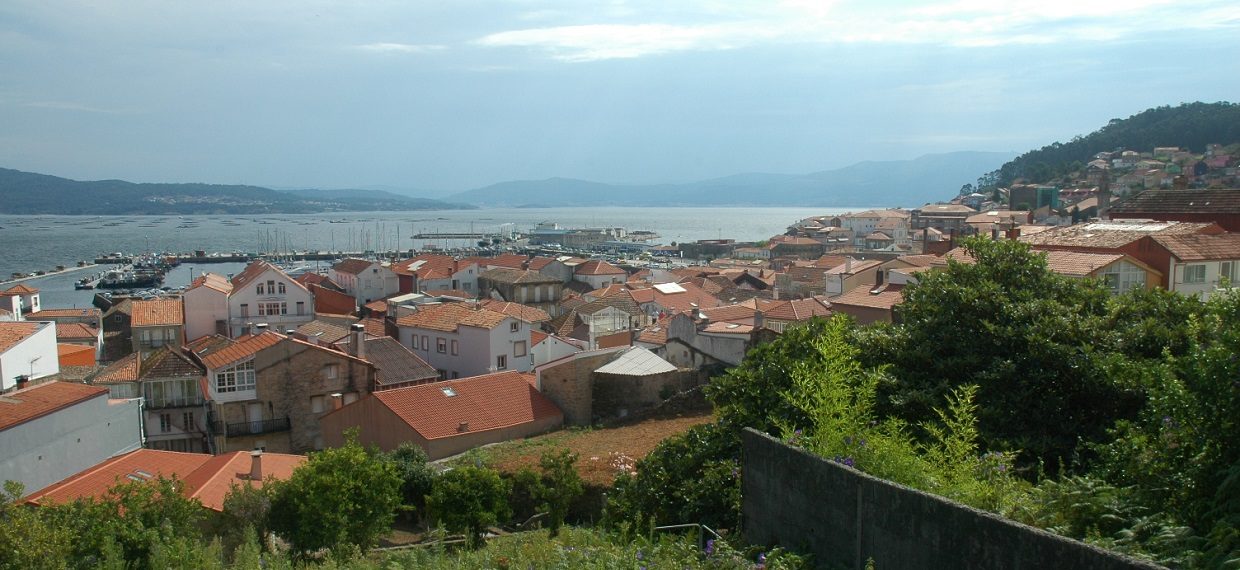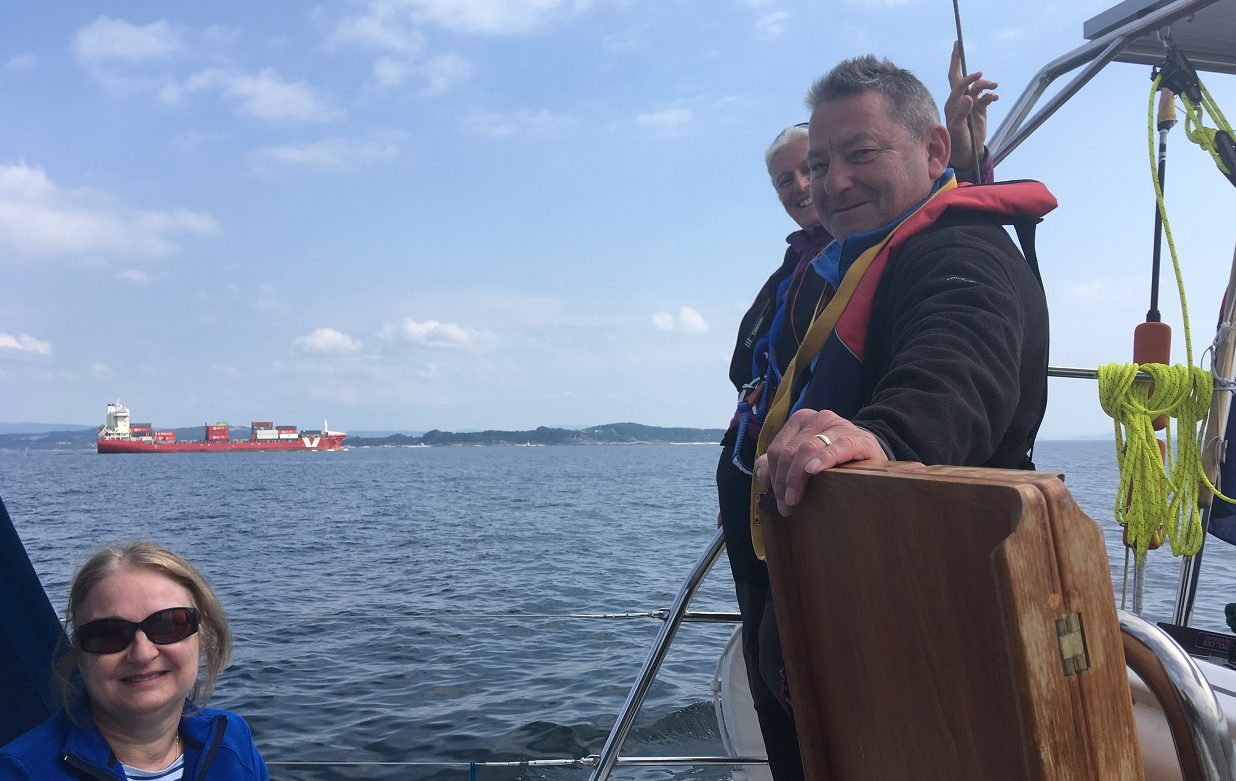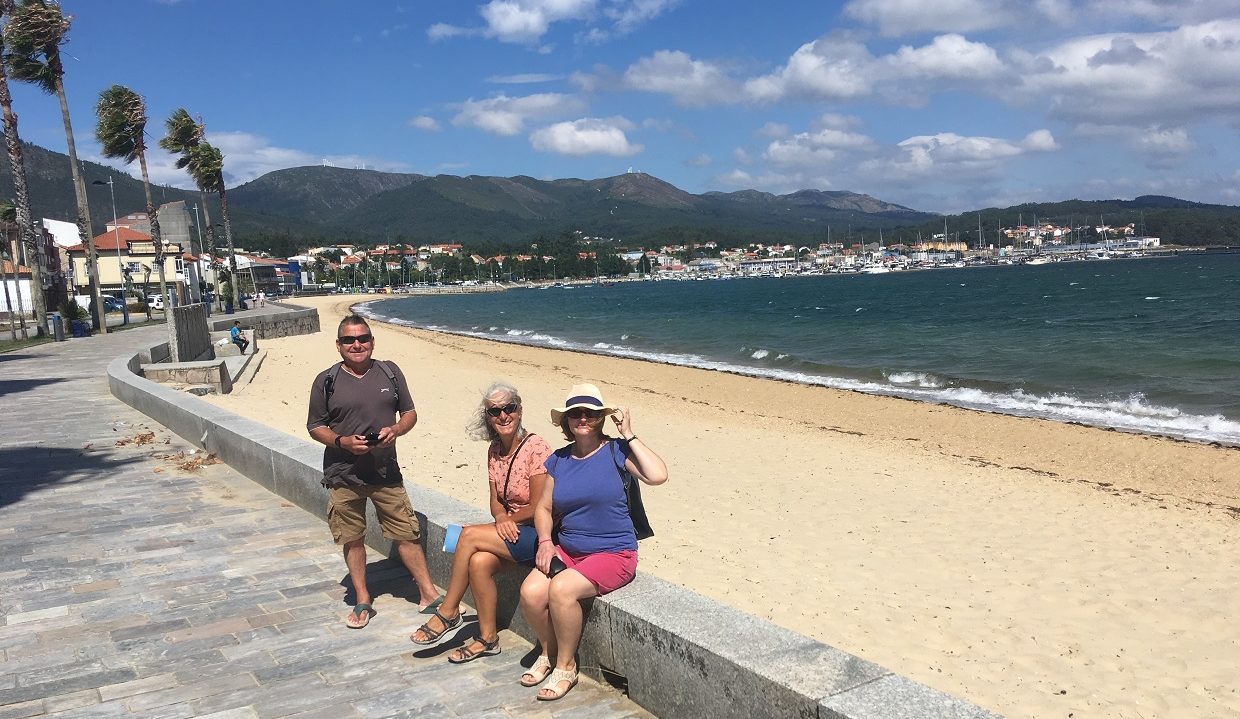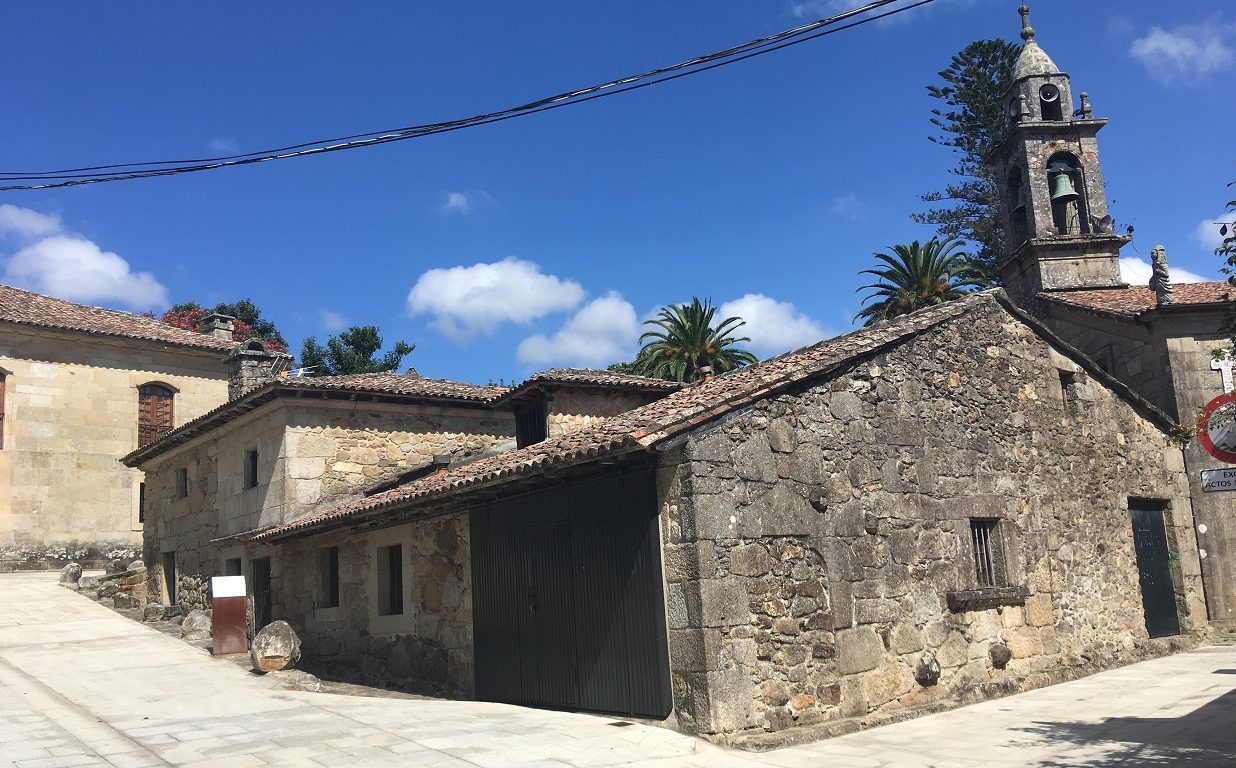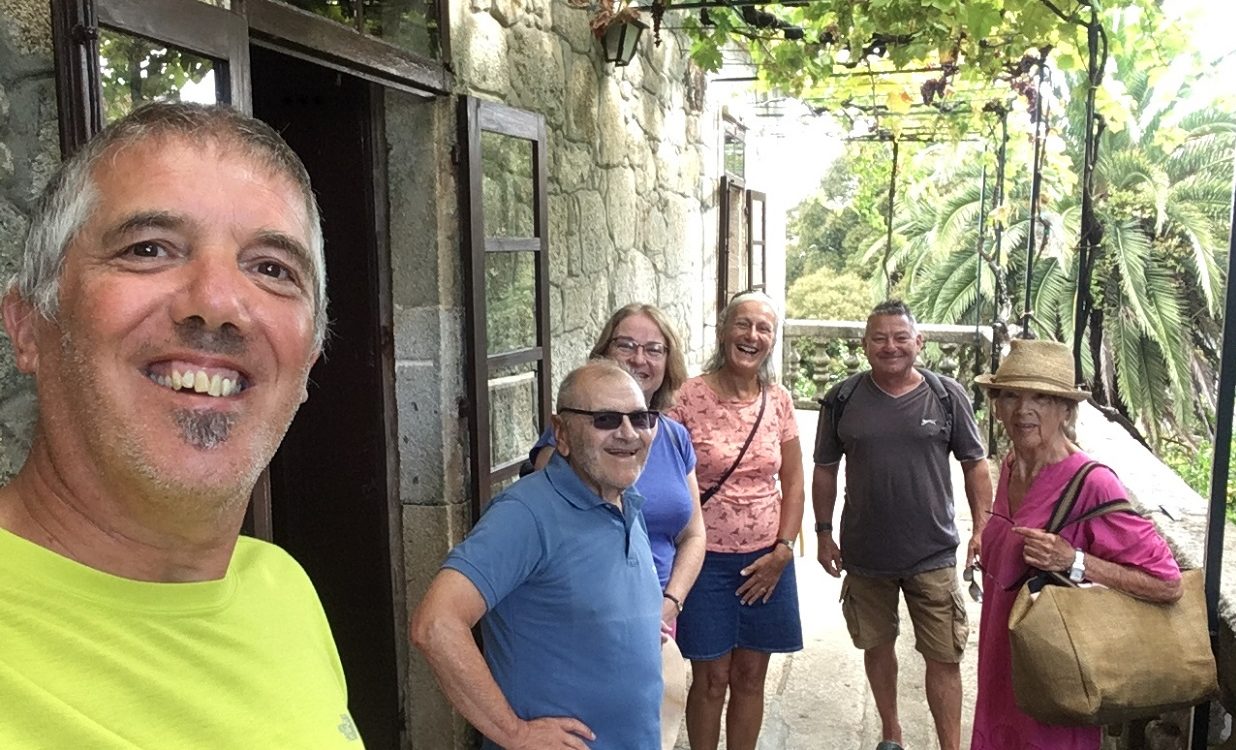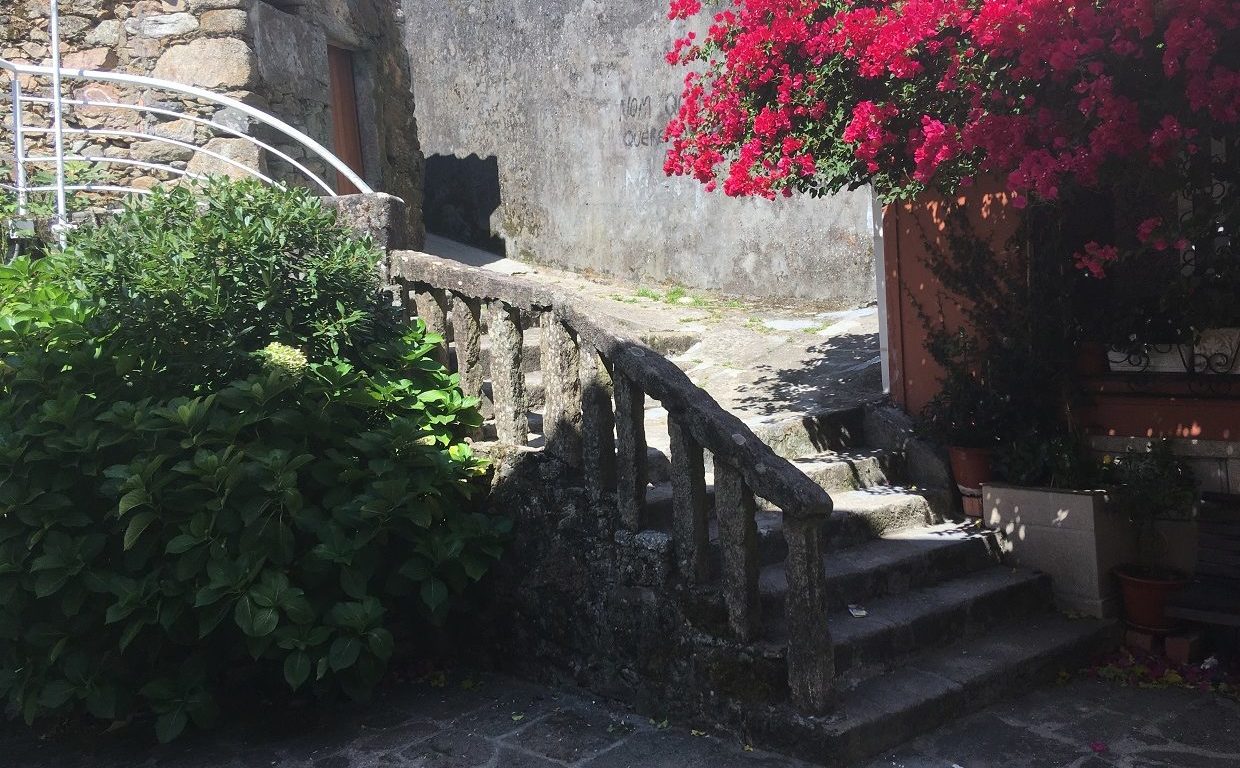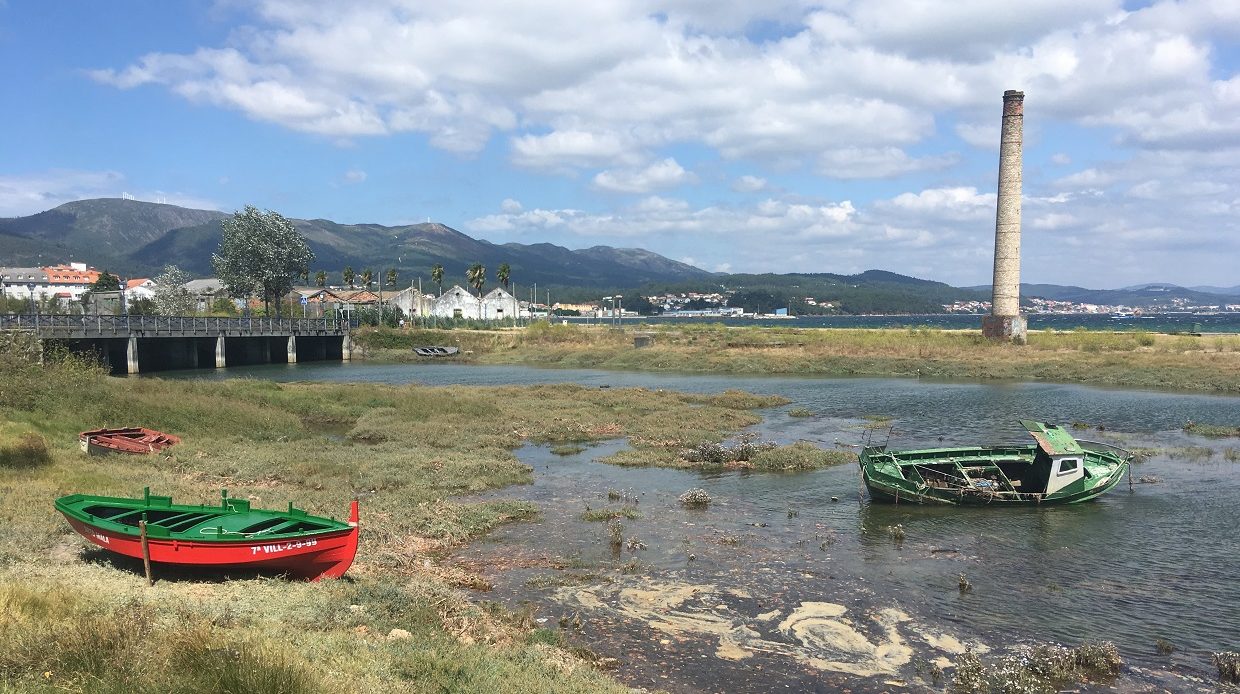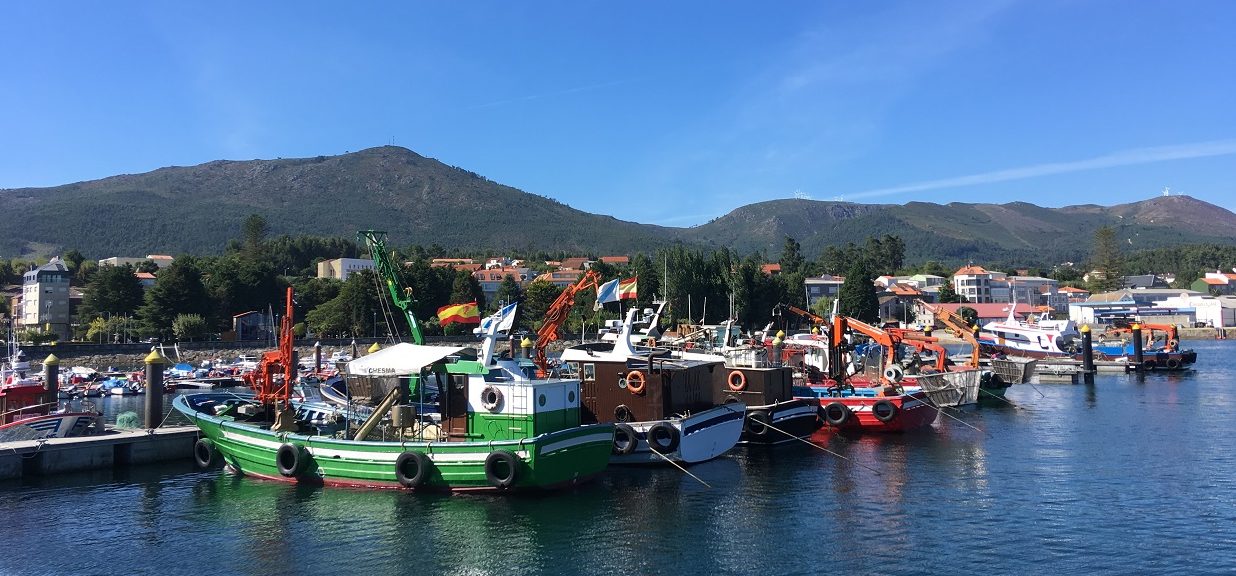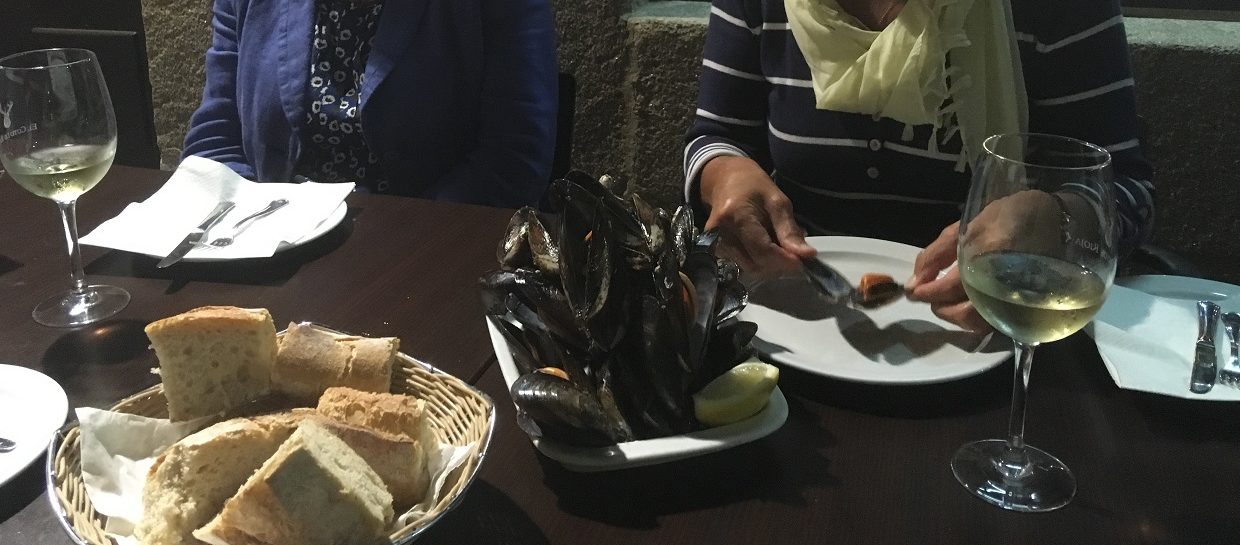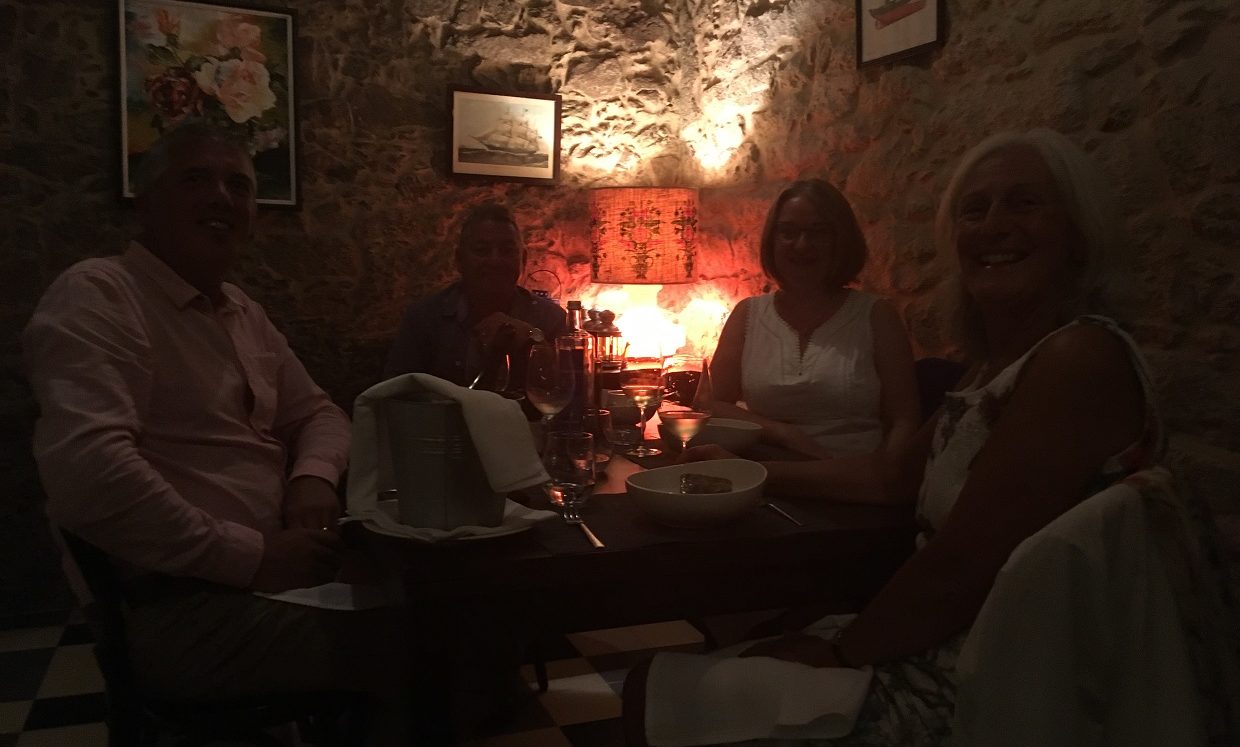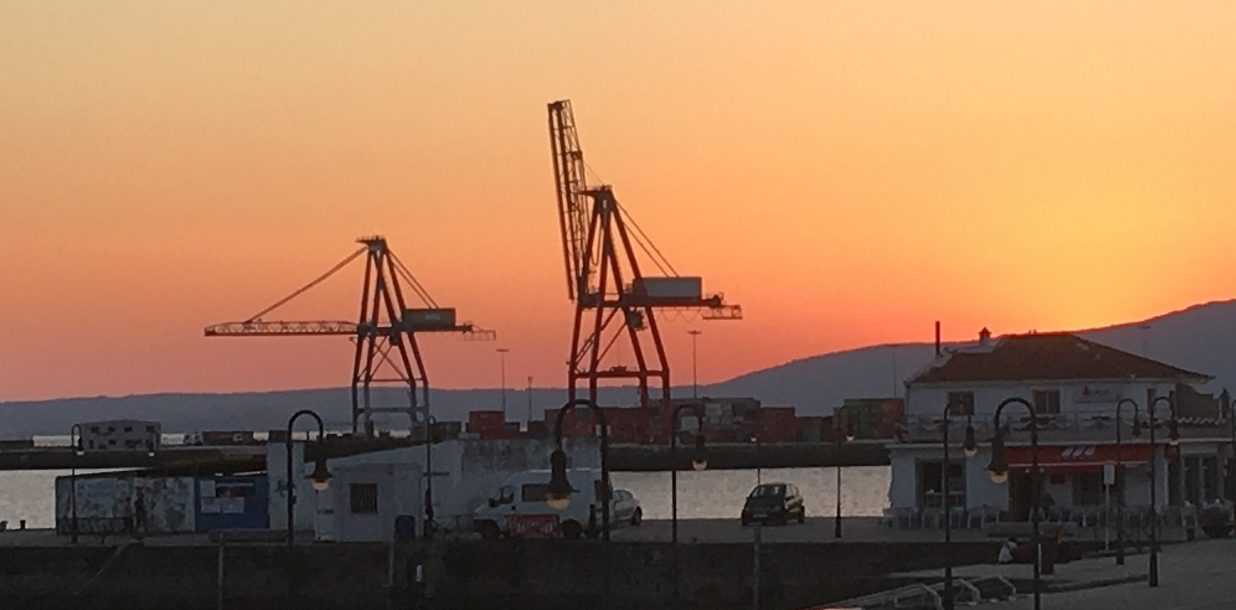
We had agreed to meet our friends Mark and Sue in Portosin on Sunday 2nd September, subject to weather conditions allowing us to get there in time. If not, the airport at Santiago de Compostela is equidistant from many of the stops on the way there, and as they were arriving mid-evening on a Sunday, the Cookies had booked an airport transfer taxi.
As it turned out we had enjoyed excellent conditions for sailing South and had arrived in the Ria de Muros Y Noia a few days before the appointed date. On Saturday morning we motored out of the Muros anchorage and through the bateas in beautiful sunshine and no wind – it was so calm that Paul took the anchor riding sail down en route!
Real Club Nautico Portosin is a relatively new marina with its 2007 club building. It was constructed within a large fishing harbour (masts in the marina seen here in the distance) and was granted royal (“Real”) status quite recently.
The reception was all very friendly as we booked in – we took advantage of it now being a the first of September to enjoy the reasonable low season rate for yachts up to 12 metres of 22.40 euros a night. The high season rate (the day before) would have been 36 euros less a 15% discount for being members of the Cruising Association (although we would have been given the same discount on production of the “ASNauga passeporte”). There are no discounts on the low season rate. Payment of the fee entitled us to use the good shower/wc/laundry facilities as well as the lovely terrace bar and restaurant on the second floor of the building. That was good enough for us, but we were also showered with gifts – a floating key ring and a bottle opener (each inscribed with the club logo), a free drink in the bar and a bottle of local Albarino wine (which turned out to be quite a good one!)
We had a wander around the town, which turned out to be slightly disappointing – it was pleasant enough and there was nothing we could pin our disappointment on – but then we realised that so far almost everywhere had been amazing in one way or another, and this was a bit ordinary by comparison.
Through the town were several bar/restaurants and on the main road running through a few shops and a bank. Heading along this road East out of town we came to a medium sized Gadis supermarket, although were surprised that it had no fish counter (and the only pescaderia in town closes on Saturday – so nowhere in this fishing port to buy fish at the weekend!)
Dropping down from the main road we came across pretty beaches just to the North of the town and then walked through a small wood to get back to the marina.
In the marina we met Peter Haden who has been sailing the Spanish Rias for many years, mostly single handed as his wife suffers motion sickness. By coincidence Paul had found a Yachting Monthly online article featuring Peter only a couple of weeks ago and recognised him soon after he related his experiences. The article can be found HERE.
Peter invited us for drinks aboard his yacht and we spent a very interesting hour or two with him – a great host! He told us that there was due to be a procession from the local church at around 7.45pm on Sunday, and that the pavement would be decorated with flowers and coloured salt.
On Sunday morning we set about turning our 1 bedroom plus 2 storeroom boat into a 2 bedroom 1 storeroom boat, by removing all of the contents of the 2 aft cabins into the saloon and re-storing them in hopefully logical fashion into the port aft cabin (so that hopefully we wouldn’t need to go digging around for anything we might need). This was a major operation in a very warm boat which at one point was a complete bomb-site!
When we had finished we walked along to the long beach to the South of the centre – a nice beach, full of people but with an unattractive backdrop of unattractive apartment blocks! Nothing like as nice as the much prettier beaches to the North.
Later we watched the procession from the church – we had heard of the local tradition of decorating the streets and whilst this was a short stretch (commensurate with the size of the town) we were not disappointed! Here the procession …..uhm…..processes over the decorated street:
As the priest lead the congregation across the main road towards the town centre we took our leave and arrived back at the marina just a few minutes before the Cookies arrived. They had visited Calypso for a weekend previously during our time in Scotland, and we were all looking forward to five nights together. Now we have been told that guests aboard a yacht are like fish – lovely for 2 or three days – but then they go off. Let’s see…..!
After stowing bags aboard Calypso we headed straight to the yacht club terrace bar where we watched the sun go down over cold beers and Albarinos before enjoying a meal in the restaurant.
The next morning, after breakfast we headed of for a walk – we were to stay 2 nights in Muros and so there was no need to rush off.
We walked up a narrow road that runs to the right of the church from which the procession……uhm…..processed the night before. As we rose through very pretty woodland and passed the cemetery an elderly gentleman stopped his mini tractor/trailer combo (on which he had collected a few dozen pine cones) and cheerily asked if we needed any help (we think!) With the customary friendly wave (the people here in Galicia are indeed very friendly) we went on our way – as a sea fret rolled in! Just our luck – we had seen fantastic weather over the past week and a sea fret arrives to greet the Cookies!
We walked back via the lovely beaches to the East of the marina, stopping for a cuppa in one beach bar, and then back to the boat before setting off across the ria to Muros, 2.5nm away.
We had enjoyed Portosin for the very friendly yacht club (with its good facilities), the woodland walk and the lovely beaches to the North, and in spite of the slightly ordinary town we would go back, if only in order to catch the bus to the nearby historic town of Noia, which we missed on this occasion.
Fortunately the fog lifted as we headed out, and was replaced with blue sky by the time we arrived in the modern Muros marina:
The pontoons are very modern, but the office and facilities are in a converted quirky old building. This contains the toilets and showers and also two sitting rooms, replete with sofas and chairs – available for our use and no doubt great if a few boats want to have a get together!
Marina-master Pedro is renowned as a very helpful chap, speaking good English. We met him on the pontoon as we arrived and he took our lines. He was clearly fond of a joke and his is humour dry.
When Paul checked in he visited the office with his briefcase – a little over the top, but knowing that Spanish officialdom requires much form filling and evidencing we thought that they would appreciate the briefcase gesture (and it is a convenient place to store documents of course).
Well Pedro was clearly amused and made some derisory/humorous remark about the case. Paul’s retort of “well I know that you need to see many documents and so I bring them all with me – I have my children’s birth certificates in here – would you like to see them?” did not go down well!
At this point Pedro seemed to have a little humour fail – wagging his finger at Paul he lowered the tone of his voice – “I am the harbour master………”
And there ended the banter.
We still got on with him very well though – we think!
The fee for our 2 nights was 35.36 euros for 2 nights, inclusive of a 2 night discount (but we cannot remember whether this was CA membership or a passeport – and we don’t know whether this is a low season rate as the tariff is not published on the website – but we were more than happy with the cost.)
Ros and Alan were in the marina on Musetta – we had arranged to meet them here and the six of us had a wander along the front before selecting a tapas restaurant, of which there are many; this was the first real tourist hotspot we had encountered since La Coruna. Here is a view of the marina and fishing port at the heart of the town as a misty dusk fell:
During our two days at Muros we explored the town and went for a long walk into the hills above. The town is historic with many well preserved ancient buildings, plus a few run down or in ruins and in need of restoration. The lovely indoor market building was in the first category. We bought produce from a little old lady sitting behind a few bags of vegetables which would have been grown on her patch.
The narrow streets of the town occasionally gave way to a small square dominated by a church:
………and in the dark, covered walkways the girls schemed and plotted:
Back in the marina we had a view from the cockpit across to the line of mussel batea service boats – not the clearest photo below but you can see a boat which uses a grab bucket to load and offload its mussels (most other boats appear to use a gentler technique). This boat sat here unattended by man for hours whilst a crew of seagulls picked over and sorted the live cargo!
We hiked into the hills behind Muros from the West side of the town, up through houses clinging to the hillside; through woodland….
past an isolated church……
……and across scrubland on the top of the hill……..
……before descending through the treeline at the other side of town, passing more houses clinging to the side of the hill with an amazing number and selection of horreos in this area, four shown here…
and back into the old town itself.
As we dropped down through the town, looking (and sounding) like tourists we were about to walk down the right hand side of the old market building. A couple of ladies were having a natter in the square above the market and one broke off to talk to us. She was pointing to a street that ran to the left of the market – as Paul was just about beginning to understand to the effect that ” this way is better, turn right and you will come to the same place”, the lovely lady gestured us to follow her and she lead us along a very old and lovely section of the town – just a couple of streets that did, indeed, lead to the same (“mismo”) place, and a well worthwhile diversion. Another confirmation that Galicians are, indeed, delightful people!
After 1 night in Portosin and 2 nights in Muros our guests were still sweet smelling fish – we were having a lovely time together, and it was time to move on into the next ria – Ria Arousa.
Our forecast was for a reasonable downwind sail in a 2 metre swell. However after a good start with brisk winds pushing us along at 5-6 kts, the wind fell as we left the mouth of the ria and a very lumpy quartering sea made our 4 kt progress somewhat painful. Sue succumbed to mild seasickness after going below – queasy and listless; she managed to hold on to her breakfast though and quickly recovered.
As we neared Ria Arousa Paul opted to enter the ria the long way round – avoiding the very narrow “Canal de Sagres” through solid looking rocks (the inner rocks viewed here in much calmer conditions from within the ria):
We would have taken this route for the first time only in very calm conditions as Paul, living up to his Adam anointed nickname of “Cautious Kevin”, is indeed a cautious Kevin! The long way around only adds around 5 or 6 nm to the trip – just an hour or so to most, but with our propeller – and a North Easterly wind blowing down the ria, it added 2 hours to our day at sea!
The sea state in the ria was calm, but a 16-20 knot headwing made for slow progress – however the crew remained cheerful even though our 36 nm passage took 10.25 hours!!!
The trip was well worthwhile, however, as our destination, A Pobra Do Caraminal, turned out to be another gem. This is a tourist destination comprising an old town sitting behind a long stretch of beach – next to the port and marina:
The tourist office gave us a map with around 30 buildings of architectural or historical interest and which lead us on an interesting tour of the town.
At the heart around the old Church of Santiago da Pobra do Dean (14th to 19th century) are a couple of large manor houses, one dating back to the 16th century, with extensive grounds enclosed by high walls.
The 16th century Casa Grande de Aguiar is visible to the left of this photo. Satellite images show that the owner has created an impressive pitch and put course in the grounds!
Next to it is the 18th Century Pazo do Couto, again in private ownership. As Paul looked through the gates, reading from the guide, the elderly owners were opening the gates to leave in their car. A cheery “hola buenas dias” goes a long way in these parts – and the lady invited us in and took us to the side of the house to show us the large mermaid sculpted in the stone wall “Sirena” she said, pointing to the sculpture, and an impressive Sirena it was.
The area is known as Costa de las Sirenas (coast of mermaids) after the legend of a fisherman who captured the mythological mermaid in his nets. In love with her he stripped her of her scales and they had children – spawning a lineage known as the Marin(y)os de Lobeiro. I think that the kind lady told us some of this story but our Spanish was not up to following. We understood “sirena” and we understood a lovely gesture.
We thanked the sen(y)ora profusely for this kind gesture, but better was still to come and we were invited into the 300 year old manor house for a tour of this remarkably well preserved gem of a building. The house had been in this family for generations and must have changed little in this time – the hand painted wallpaper must have been over a hundred years old. This was better than any museum tour, and was another example of how friendly and generous the people in this area are.
Sue did almost get us ejected when wanting to know how many years the couple had lived here. However she did not realise the relevance of the little squiggle that sometimes sits above “n” in Spanish words. It turns a simple “n” into “ny”. It turns Marinos (above) into Marinyos. And it turns anos (which Sue said) into anyos (which is what Sue should have said).
So instead of asking “how many years here?” – Sue managed to ask “how many arseholes here?”!! Fortunately Paul’s 2 years of night-school Spanish came to the rescue and he quickly corrected her, sharing a wry smile with sen(y)or.
Before we left we asked for a photograph to remind us of our visit – and here we all are on the first floor balcony, in the shade of an old vine:
Our self-guided tour of the town continued, with interest from grand old buildings juxtaposed among modern development, from the old town hall fronting the busy main street to modest old houses in quiet corners, an art deco cinema and modern apartment blocks all rub shoulders – here a new balustrade picks up where the ancient granite one ends:
We had the choice of either staying here one night and moving on, or staying a second night and crossing the Ria to Vilagarcia on Friday morning to drop the Cookies at the station to catch an afternoon train to Santiago. The vote was unanimous – to stay.
In the afternoon we walked along the beach to a wetland nature reserve. This sits behind a derelict old industrial area at the end of the beach. The industrial buildings to left of centre in the photograph below have no roofs. The lone chimney is the last remnants of an industrial facility that must have once sat on a narrow spit of land behind the beach, between that and the creek flowing from the wetland area.
The principle activity here now, in addition to tourism, would appear to based around shellfish – both raking the seabed for clams (there are 40+ clam dories in the port) and the rearing and processing of mussels – judging by the batea support fleet in the harbour (this is not half of it):
On our first night we had an excellent tapas meal at Kunka taperia – the first course to arrive was a plate of huge mussels – the largest we have eaten but still sweet and tender.
On our second night we had a superb meal at the Nojira restaurant. This is located on the seafront towards the Gadis supermarket – but hides away in a lovely old building with just a small silver plaque to mark its presence. It is well worth seeking out; offering a limited menu of Spanish and fusion dishes with an Asian influence (Thai/Japan rather than Indian sub-continent). A few cruisers have commented that every restaurant has the same menu of fish and shellfish dishes with the odd steak and pork dish thrown in, all served in the order decided by the chef so not to be eaten as a structured meal. This is certainly much more creative than most and is served course by course. The owner/chef spent a year in Manchester and speaks good English – you should visit if in the area! And thanks to the Cookies for treating us to this one!
Our fishy visitors were still fresh and we were sorry to see them leave. On Friday morning we made the 7 nm crossing to Vilagarcia under mainsail alone. We arrived and tied up in the marina (having rejected and hastily reversed out of the first pontoon offered by the marinero which was barely half the length of the boat).
Our final meal together is shown in the photo at the top, after which we had a 10 minute walk to the station to wave the Cookies off; our 5 nights together having flown by too quickly.
There will be more to say about Vilagarcia in the next blog, but as we reflected on our time with visitors over a beer on the marina bar terrace, watching the sun go down – the skyline reminded us of the view of Falmouth port from our birth in Pendennis marina just 2 years ago:
Distance traveled since leaving Arzal – 749 nm
